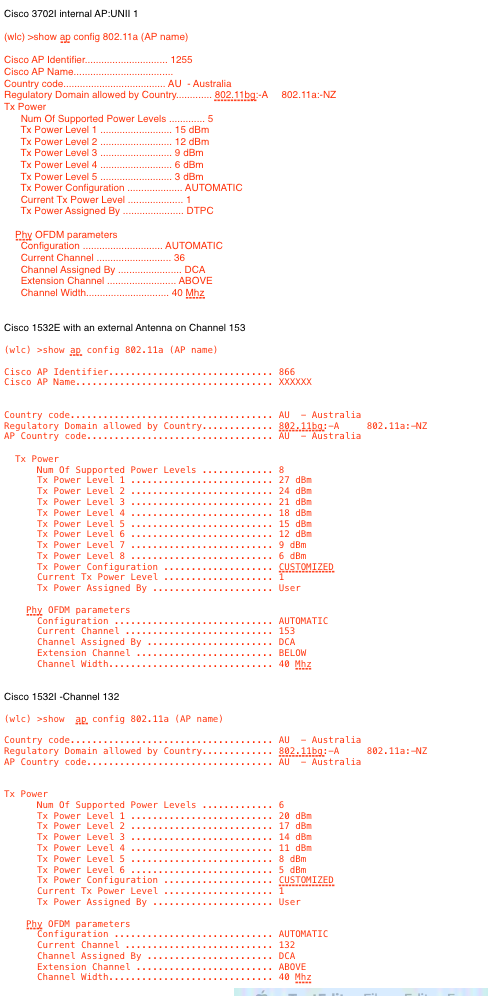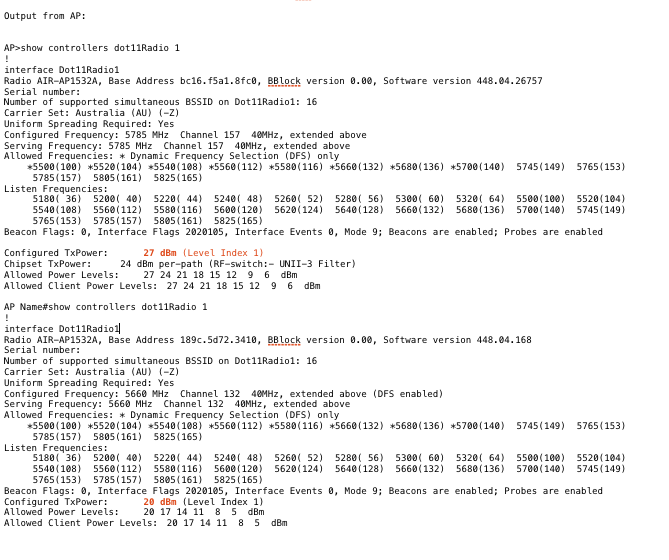In this blog, I would like to explain how we could interpret transmit power levels on the Cisco controllers and access points.
On 2.4 Ghz, the transmit power levels is not that complicated.it is pretty much dependent on the allowed transmit power and antenna gain. The max power level shows 23 dBm with power levels ranging from 1 to 8, where Power level 1 is 23 dBm.
These values vary more on 5 GHz frequency bands compared to the 2.4 Ghz frequency bands. To keep it simple, I would state that ” On 5 GHz radio frequency, we accurately cannot determine the EIRP / transmit power of an AP + Antenna by looking at the power levels on Cisco WLC unless we dig deeper to clarify the same”.
To keep it simple, I would state that ” On 5 GHz radio frequency, we accurately cannot determine the EIRP / transmit power of an AP + Antenna by looking at the power levels on Cisco WLC unless we dig deeper to clarify the same”.
Below is the categorisation of 5 GHz frequency:
UNII-1 channels =36,40,44 & 48
UNII-2 channels = 52,56,60 & 64
UNII-2e channels =100,104,108,112,116,120,124,128,132,136 & 140
UNII-3 channels =144,149, 153, 157 , 161, 165
These power levels are dependent on various factors like AP Type, assigned channels, regulatory domain, antenna gain etc.
Depending on the UNII band/frequency of the AP, the power levels are different on the 802.11a 5GHz radio.
On Cisco WLC, transmit power level is a numeric value instead of an unit in mW or dBm.
The numeric value corresponds to a power level that varies depending on the regulatory domain, frequency used and antenna gain.
Power level 1 is always the maximum power level allowed for that particular access point, deployed in a particular country and operating on a particular channel.
We can safely consider that each successive power level represents 50% of the previous power level. For example, 1 = maximum power level in a particular regulatory domain, 2 = 50% power, 3 = 25% power, 4 = 12.5% power, 5=6.25% etc.
If you set the maximum power level assignment under RF profile, the max transmit power level under the WLC will not be this max value but it takes the max value of the radio in that regulatory domain along with its antenna gain.
For some reason, quite often, I have also noticed that transmit power levels are reduced by 1 dB than the actual allowed values: Eg: if max allowed power is 23 dB, have seen it as 22 dB on the WLC and AP.
Below are the commands that can be used on plc or AP to see the transmit power levels:
On WLC:
for 5 GHz ” show ap config 802.11a (AP name)”
For 2.4 GHz “show ap config 802.11b (AP name)
On the Access point:
show controller dot11radio 1
show controller dot11radio 0
Based on the output you can see that different access points operating on different channels show different power levels.
The best way to validate transmit power is by using above 2 commands.
Please note that the antenna gain has to be configured manually on the wireless lan controller

